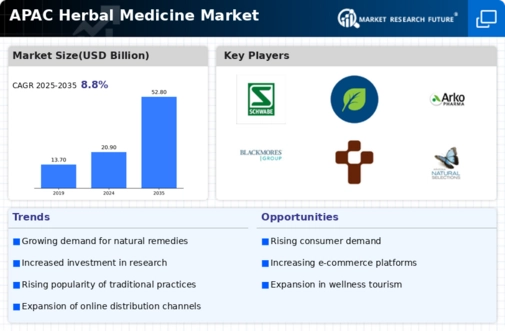APAC Herbal Medicine Market Summary
The Asia-Pacific herbal medicine market is projected to grow from 20.87 USD billion in 2024 to 52.78 USD billion by 2035.
Key Market Trends & Highlights
APAC Herbal Medicine Key Trends and Highlights
- The market is expected to experience a compound annual growth rate of 8.8 percent from 2025 to 2035.
- By 2035, the market valuation is anticipated to reach 52.8 USD billion, indicating robust growth potential.
- in 2024, the market is valued at 20.87 USD billion, reflecting a strong foundation for future expansion.
- Growing adoption of herbal medicine due to increasing consumer awareness of natural remedies is a major market driver.
Market Size & Forecast
| 2024 Market Size | 20.87 (USD Billion) |
| 2035 Market Size | 52.78 (USD Billion) |
| CAGR (2025-2035) | 8.80% |
Major Players
Schwabe, Nature’s Bounty, Bionorica, Arkopharma, Blackmores, Tsumura, Arizona Natural, Nelsons, Bio-Botanica, Sanjiu, Herbal Africa, Yunnan Baiyao, Tasly, Zand, Tongrentang, SIDO MUNCUL


























Leave a Comment